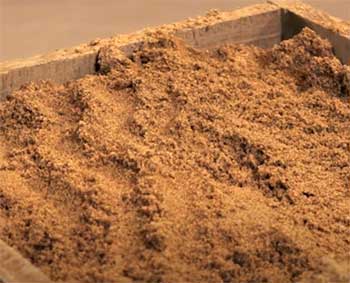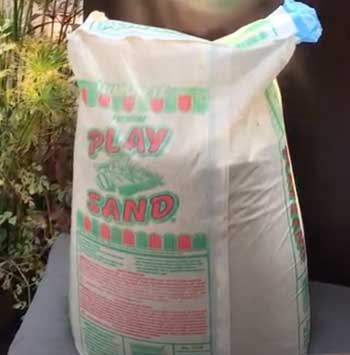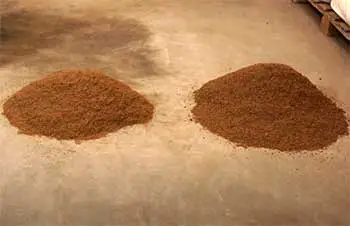Are you trying to make a sandbox?
Then, you have to go through the process of choosing the right kind of sand. Typically, with sandboxes, there is a choice of choosing between masonry sand vs play sand.
You can’t decide on one of them without knowing about the sands and how they impact your builds. So, that’s why I will be going through an in-depth comparison between the two types of sands to give you a clear picture of what you are dealing with.
Let’s get started with it.
Comparison Table Of The Masonry Sand And Play Sand
Let’s take a quick look at the table to compare the different choices. This will be helpful if you are short on time to choose a sand option.
| Specification | Masonry sand | Play sand |
| Grains | Fine | Finer |
| Usability | Multipurpose | Not suitable for a lot of purposes |
| Safety | Not the safest | Comparatively safe |
| Processing | Decent | Thorough |
| Price | Reasonable | Expensive |
While this is good for getting a general idea, it’s not the best way to find out the better option for your needs. Following up with that, I will be diving deep into the comparison, so I recommend you check that out to see how each choice comes out.
In-detail Comparison Of Masonry Sand And Play Sand
Well, in reality, both of them are sands, right?
So, you won’t get too many differences between the two options. Some of the differences that they portray are just things that impact the application of the sands. Let’s get through them quickly –
- Purpose of Use

The first and major difference you get to see between the two grains of sand is in their application. Where you use each of these sands is different.
Usually, masonry sand is all-purpose sand that you can use in various scenarios.
You can use the sand for making mortar or smooth concrete used for brick layering.
People also use these sands for filling up playgrounds and volleyball fields too.
On the other hand, playing sand is just the perfect option for sandboxes. Other than that, there aren’t many uses for playing sands.
This means in terms of versatility, playing sand is not the option. But if you are making sandbox, then it’s the go-to pick.
- Grains
Now, let’s talk about the grain element for both the sands. Typically, you will know that masonry sand has some of the finest grains in the construction sands category.
However, play sands take that further and produce even finer grains.
Because of that, they are much more comfortable to sit and play on compared to masonry sand. Still, masonry sand is quite fine in the grains compared to the other kinds of sands out there.
- Content of The Sands
The kind of content sands has mostly depends on where it comes from. Usually, the rocks from the quarry decide the content they will have.
For example, you can get sand from limestone, granite, quartz, and other rocks. Note that these are some of the most common ones.
Having said that, there another element that can be present in the sand is crystalline silica. Now, this is an element that can raise some safety questions.
When you inhale this crystalline silica, you are essentially putting your respiratory system at risk.
Both the sand types have this content in them. However, some variants of play sand don’t seem to have any silica. This makes those play sands much more preferable when you think about safe usage of the sand.
- Sand Source

Well, just like any other sand, both these grains of sand come from either rock mines or quarries.
There are no other options for getting sands.
Now, it’s not like you get all the sands ready-made. They go through some processing to make the sands something that you can use for your particular purposes.
The difference you get to see between these two sands types is their processing.
Masonry sands don’t go through a thorough process like play sands.
So, they are a little bit rougher than the play sands. However, they have their use as well, so you can’t count them out either.
- Availability
In terms of availability, I would say masonry sand is much more common and available almost wherever you go. But play sands aren’t that available. Especially if you are looking for silica-free play sand, you will go through a much harder time getting them.
As for the place, you can easily look for them online or at a hardware store. Or you can also try out the sand suppliers to check their availability.
In short, masonry sand is something that you will find almost everywhere. Play sand is something that you may need to look for a bit.
- Price
There is a clear difference between the two choices in the price factor. Usually, playing sands are pretty expensive. Now, the reason for that is simple; play sands go through thorough processing, which costs quite a bit.
On the other hand, masonry sands are very easy to process, so they don’t cost as much. Also, if you are thinking of silica-free play sands, you may even need to pay a lot more.
As you can see, since they both are sands, you don’t get that many differences. Still, few differences can impact the choice a lot.
Also, you have to think about the usage factor and the purpose of using your sand.
Key Characteristics of Masonry Sand
Masonry sand has several characteristics that make it suitable for construction purposes:

- Particle size – The grains of masonry sand are coarser than other sands. It contains a mixture of grain sizes ranging from fine to granule size. This helps the sand compact tightly and bond well.
- Texture – As mentioned earlier, masonry sand has a rough, gritty texture. This is ideal for concrete bonding. Smooth sands cannot properly hold the cement mixture.
- Composition – Masonry sand is typically composed of crushed stones like limestone, granite, quartz, or sandstone. This crushed rock composition allows greater strength and durability.
- Color – The color can range from tan to reddish-brown depending on the rock material used. White masonry sand is also available which is made from crushed white limestone or quartz.
- Angular grains – The crushed angular grains of masonry sand make it non-compressible. This provides firm support for construction materials.
- Moisture content – Masonry sand has balanced moisture content, neither too wet nor too dry. This allows optimal workability for concrete and mortar mixing.
Common Uses of Masonry Sand
Masonry sand is extremely versatile for many construction applications. Here are some of its most common uses:
- Concrete mixing – Masonry sand forms the base for concrete. It greatly improves concrete strength and workability. The angular sand grains create friction that makes concrete dense and strong.
- Mortar beds – Mortar made with masonry sand is used to lay brick, stone, and block. It binds these materials together firmly. The coarse texture allows excellent binding between mortar and construction block.
- Paving sand – Sand used between paving stones is often masonry sand. It compacts tightly and sets the pavers firmly in place. River sand cannot be used here as it shifts too easily.
- Fill sand – Masonry sand can fill voids in blocks and bricks. It is used for backfilling materials like electrical cables. The angular sand locks together for stability.
- Plastering – Masonry sand is mixed with cement and lime for plaster coats on walls. The coarse grains provide the right texture and bonding properties for plastering.
- Traction sand – Spreading masonry sand provides good traction on slippery surfaces like snowy driveways and roads. The coarse grains provide friction to car tires.
What To Look For When Buying Masonry Sand?
If you’re purchasing masonry sand for a project, inspect it closely to ensure you get high-quality sand. Here are some things to look for:
- Coarse gritty particles – Avoid sand that feels overly smooth or fine. Proper masonry sand will feel gritty to the touch.
- Range of grain sizes – There should be variation from fine to granule particles. This allows dense compaction.
- Free of organic material – Ensure there are no traces of debris like grass, roots, or wood chips. This can weaken concrete integrity.
- Angular grains – The crushed stone particles should have sharp edges, not smooth round shapes.
- Color – Check the sand color which varies based on the rock material. Be sure it meets any specifications you require.
- Moisture content – The sand should be damp but not soaked. Too much moisture makes concrete mixing difficult.
Purchasing from reputable suppliers is highly recommended to ensure you get high-quality masonry sand ideal for construction needs.
Key Characteristics of Play Sand
Now that we’ve covered masonry sand in detail, let’s look at what sets play sand apart:
- Particle size – Play sand grains are much finer than masonry sand. The particles are smooth and flow freely through fingers.
- Texture – Play sand feels soft and smooth. When squeezed in your hand it retains shape and easily molds.
- Composition – Play sand can be made from crushed rocks or be naturally occurring sand found in deserts or rivers. This makes it smooth in texture.
- Color – It commonly comes in a natural tan/beige color. Though colored sands are also available like red, green, blue for sensory play.
- Rounded grains – Play sand particles are rounded rather than crushed and angular. This prevents scratching and allows easy molding.
- Low dust content – Play sand is filtered to remove dust and super fine grains. This keeps it safe for kids and prevents inhalation issues.
- Moisture resistant – Play sand is less prone to clumping when wet. It provides good drainage and dries fast after rain.
Common Uses of Play Sand
Let’s look at the many ways play sand is used for kids’ recreation:
- Sandboxes – This is the most obvious use for play sand. It provides hours of fun for kids to dig, mold, and build in sandboxes.
- Play structures – Play sand is ideal for building sand castles, digging pits, and other fun structures that encourage interactive play.
- Sand tables – Special tables with bottoms filled with play sand allow kids to engage in sensory play by molding and shaping the sand.
- Kinetic sand – Mixing play sand with an additive like silicone oil makes kinetic sand. This allows molding more defined shapes.
- senory stimulation – Play sand offers tactile stimulation for kids. Running hands through the soft sand provides sensory play experience.
- Sand art – Colored play sands are great for making sand art. Kids can make vibrant sand paintings or patterns by layering different colored sands in containers.
- Trays – Filling shallow trays with play sand allows kids to engage in sandbox play indoors or on patios. The fine sand is easily contained.
What To Look For When Buying Play Sand?
You’ll want to inspect play sand for the following qualities before purchasing it for kids:
- Very fine & smooth grains – Rub it between your fingers to check for a smooth, silky texture without coarse particles.
- Tan/light color – Natural looking sand color is ideal. Colored sands are also available.
- Minimal dust – Quality play sand will not have a dusty appearance or residue when rubbed between hands.
- Good drainage – Moisten a handful of sand. It should not retain water or become clumpy.
- Unscented – Avoid scented sands as the chemicals can irritate sensitive skin. Go for natural unscented sand.
- Packaging – Buy from reputable brands and check no tears or leaks in the packaging that could contaminate the sand.
- Certified safe – See that the sand is certified by consumer safety organizations to ensure it’s free of harmful substances.
Choosing a high-quality play sand ensures a safe and pleasing sensory experience for kids during sandbox play.
What Is The Suitable Pick For You?
There is no one true pick that you can just use for any case. It mostly depends on the purpose of your use.
For example, if you are making a sandbox for your kids, there is no better pick than playing sand. Other than that, I would say masonry sand is the better pick.
Also, if you are thinking about a budget option in any case, then masonry sand is much more affordable.
Frequently Asked Questions (FAQ)
People often ask some common questions regarding masonry sand and play sand –
No, play sand tends to be much finer than masonry sand. You get finer grains on play sands that are more comfortable on your skin. Also, some play sand can be silica free, so they are much safer to use.
No, you can’t use play sand for making mortar mix for concrete because the grains on the play sand are much finer than other sands. But concrete or mortar mixes require some rough edges. Otherwise, they are not effective.
While it may not be the ideal pick, you can use play sand in concrete for almost any project. It will not yield the best results because of the finer grain on them. But it indeed works out.
The most fundamental difference you get between play sand and builders’ sand is the grains. Play sands are much finer than builders’ sand, and that’s what makes them suitable for sandboxes.
Conclusion
To sum things up, I would say masonry sand vs play sand isn’t even a debate to talk about. It’s very clear; if you make a sandbox, you pick play sand.
If you are doing anything other than that, masonry sand is a better pick. Is masonry safe for sandbox?
Well, no, but can you use it to save up some money? Yes. That’s pretty much the end of it.
